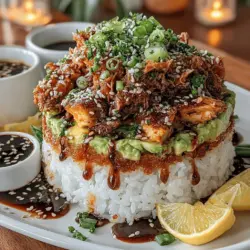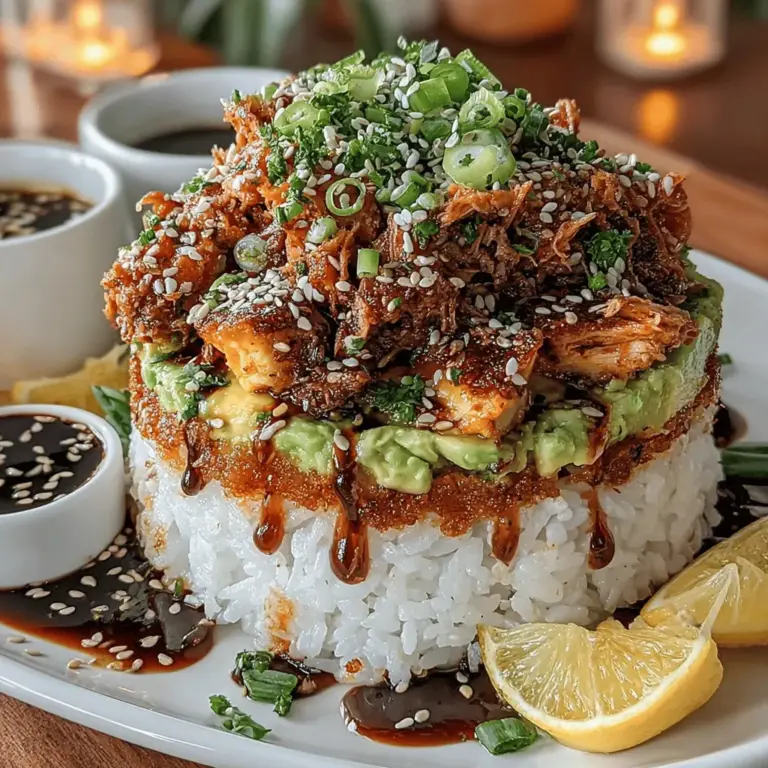Spicy Tuna and Avocado Sushi Stack: A Delicious Fusion of Flavor and Presentation
Sushi has transcended its traditional roots in Japan to become a beloved culinary art form enjoyed worldwide. The delicate balance of flavors, textures, and artistic presentation has made sushi not just a meal but an experience. As sushi continues to captivate food enthusiasts, one dish that stands out for its vibrant colors and satisfying taste is the Spicy Tuna and Avocado Sushi Stack. This recipe is a perfect introduction for those who are new to sushi-making while still delighting seasoned sushi lovers.
The Spicy Tuna and Avocado Sushi Stack is not only visually appealing but also embodies a harmonious blend of fresh ingredients and bold flavors. The creamy avocado contrasts beautifully with the spicy kick of the tuna mixture, creating a dish that is both delicious and satisfying. Whether you’re hosting a dinner party or simply indulging in a cozy night in, this recipe is sure to impress.
Understanding Sushi Rice
A key component of any sushi dish is the rice, specifically sushi rice. Sushi rice differs significantly from other rice varieties due to its unique texture and flavor profile. It is short-grain rice that becomes sticky when cooked, allowing it to hold together well and maintain its shape when formed into rolls or stacks. This sticky quality is essential for sushi, as it helps bind the ingredients together, making it easier to eat and enhancing the overall presentation.
How to Prepare Sushi Rice
To achieve the perfect sushi rice, it’s crucial to follow a specific preparation process that enhances its flavor and texture. Here’s a step-by-step guide to help you prepare sushi rice like a pro.
1. Rinse the Rice: Begin by measuring out the desired amount of sushi rice. It’s important to rinse the rice under cold water to remove excess starch, which can lead to overly sticky rice. Rinse until the water runs clear, indicating that most of the starch has been washed away.
2. Soak the Rice: After rinsing, soak the rice in fresh water for about 30 minutes. This step allows the grains to absorb water, leading to even cooking and a better texture.
3. Cook the Rice: Once the rice has soaked, drain it and transfer it to a rice cooker or a pot with the appropriate amount of water. Typically, the water-to-rice ratio for sushi rice is 1:1. This means that for every cup of rice, you should use one cup of water. Cook according to the rice cooker instructions or bring to a boil, then reduce to a simmer and cover for about 15 minutes until the rice is tender.
4. Season the Rice: While the rice is cooking, prepare the sushi vinegar mixture by combining rice vinegar, sugar, and salt in a small bowl. Once the rice is cooked, transfer it to a wooden or glass bowl (avoid metal, as it can react with the vinegar) and gently fold in the seasoned vinegar. Be careful not to crush the rice grains; you want to maintain their shape. Allow the rice to cool to room temperature before using it in your sushi stack.
This meticulous process of rinsing, soaking, cooking, and seasoning is fundamental to achieving sushi rice that is not only flavorful but also has the right texture to support the other ingredients in your Spicy Tuna and Avocado Sushi Stack.
Crafting the Perfect Spicy Tuna
The star of the Spicy Tuna and Avocado Sushi Stack is undoubtedly the spicy tuna itself. Selecting the right tuna is crucial; you want to opt for sushi-grade fish, which is safe for raw consumption and ensures the best flavor and texture. Look for vibrant red tuna with a firm texture, free from any off-putting odors. Your local fishmonger can help you identify the best options available.
Ingredients for Spicy Tuna Mixture
To create the spicy tuna layer, you will need the following ingredients:
– Sushi-grade tuna (finely diced)
– Kewpie mayonnaise (a Japanese mayonnaise known for its rich flavor)
– Sriracha (for that signature spicy kick)
– Soy sauce (to enhance the umami flavor)
– Chopped green onions (for garnish and added freshness)
Preparing the Spicy Tuna
1. Dice the Tuna: Start by finely dicing your sushi-grade tuna into small cubes. Aim for uniform pieces to ensure even mixing and a consistent texture in your sushi stack.
2. Mix the Ingredients: In a mixing bowl, combine the diced tuna with Kewpie mayonnaise and sriracha. The amount of sriracha can be adjusted based on your desired spice level—start with a small amount and gradually increase it as needed. Add a splash of soy sauce to enhance the flavor and mix gently until all the ingredients are well incorporated.
3. Taste and Adjust: It’s essential to taste your spicy tuna mixture at this stage. If you prefer a milder version, you can add more mayonnaise to balance the heat. Conversely, if you enjoy a bolder flavor, a bit more sriracha can elevate the spice level.
4. Chill: Once your spicy tuna is prepared, cover the bowl and refrigerate for about 15-20 minutes. Chilling not only helps in marrying the flavors but also firms up the tuna, making it easier to layer in your sushi stack.
Creating the perfect spicy tuna is a blend of precision, quality ingredients, and personal taste. By following these steps, you will ensure that your spicy tuna not only complements the avocado layer but also stands out as a highlight of the dish.
Creating a Creamy Avocado Layer
Avocado has gained immense popularity in sushi dishes, thanks to its creamy texture and nutritional benefits. Rich in healthy fats, vitamins, and minerals, it adds a luxurious mouthfeel that beautifully contrasts with the spiciness of the tuna.
Mashing Avocado for Your Stack
1. Choose the Right Avocado: Select ripe avocados that yield slightly to pressure when gently squeezed. This ripeness ensures a creamy consistency that is perfect for layering in your sushi stack.
2. Mash the Avocado: Cut the avocado in half, remove the pit, and scoop the flesh into a bowl. Using a fork, mash the avocado to your desired consistency, whether you prefer it smooth or with a few chunky pieces for texture.
3. Add Lime Juice: To enhance the flavor of the avocado and prevent browning, squeeze in fresh lime juice. This addition not only brightens the taste but also complements the other ingredients in the sushi stack.
4. Season to Taste: Depending on your preference, you may want to add a pinch of salt or a sprinkle of garlic powder to elevate the flavor of the mashed avocado. Taste and adjust as necessary.
By preparing the avocado layer with care, you create a deliciously creamy element that balances the heat of the spicy tuna, making each bite of the sushi stack a delightful experience.
With a proper understanding of sushi rice, the perfect spicy tuna mixture, and a creamy avocado layer, you are well on your way to assembling your Spicy Tuna and Avocado Sushi Stack. This dish promises to be a highlight at any gathering or a delightful treat for yourself. In the next part of this article, we will explore the assembly process and presentation tips to showcase your culinary creation beautifully. Stay tuned!
{{image_2}}
Seasoning and Texture to Complement the Spicy Tuna and Sushi Rice
Creating a delicious Spicy Tuna and Avocado Sushi Stack goes beyond just the ingredients; it’s about achieving the perfect balance of seasoning and texture. The sushi rice should be sticky yet fluffy, having absorbed the right amount of rice vinegar, sugar, and salt to provide a slight tanginess that complements the spiciness of the tuna.
For the spicy tuna, the seasoning typically includes a mix of mayonnaise (preferably Kewpie for its creaminess), Sriracha for heat, and a touch of sesame oil for depth. This combination not only enhances the flavor profile but also contributes to a creamy texture that contrasts beautifully with the soft avocado and the firm sushi rice.
When constructing your sushi stack, consider the textures of each layer. The creamy avocado should be ripe but not overly mushy, providing a smooth counterpart to the spicy, slightly grainy tuna mixture. The layering of these components is crucial for a satisfying bite, ensuring that each forkful delivers a combination of flavors and textures.
Assembling the Sushi Stack
Importance of Layering in Sushi Presentation and Texture
The visual appeal of your sushi stack is just as important as its taste. Layering is essential not only for aesthetic purposes but also for enhancing the overall texture of the dish. Each layer should be distinct yet harmonious, allowing diners to appreciate the individual components while enjoying a cohesive flavor experience.
Instructions on Using Molds or Cups for Proper Stacking
Using molds or cups for stacking is a great way to achieve a professional-looking presentation. Here’s how to do it:
1. Prepare Your Molds: If you have a ring mold, this works perfectly. If not, small cups or ramekins can be used as well. Lightly grease them with a bit of cooking spray or oil to prevent sticking.
2. Layer the Sushi Rice: Start by placing a layer of sushi rice at the bottom of your mold. Press it down gently with a spoon to create a solid base. Aim for about 1 inch in height to ensure the stack is stable.
3. Add the Spicy Tuna Mixture: Next, spoon the spicy tuna mixture over the rice, spreading it evenly. Use the back of the spoon to gently pack it down without compressing the rice too much.
4. Layer the Avocado: Cut your ripe avocados into thin slices or cubes and layer them on top of the tuna. This will add a fresh and creamy element to your stack.
5. Repeat Layers: If your mold allows, repeat the layers until you reach the top. Finish with a layer of sushi rice or avocado for a polished look.
6. Release the Stack: Carefully lift the mold off, allowing the stack to hold its shape. If using a cup, you can gently tap it against a surface to help release the sushi stack.
Tips for Ensuring the Stack Holds Together While Maintaining Aesthetic Appeal
To make sure your sushi stack stays intact, avoid overpacking any layer. Each ingredient should be firm enough to hold its shape but not overly dense. Also, let each layer sit for a moment before adding the next to allow it to settle slightly. If you find that your stack is not holding well, you can use a small piece of nori around the outside. The nori will help bind the ingredients together and provide an extra layer of flavor.
Optional Use of Nori for Added Flavor and Texture
Incorporating nori into your sushi stack can elevate the dish both in flavor and presentation. Nori is a type of edible seaweed that adds a subtle umami flavor and a bit of crunch when toasted. Here’s how to use it:
1. Cut Nori into Strips: Use kitchen scissors to cut nori sheets into thin strips or squares.
2. Layer with Nori: After layering your rice, you can place a piece of nori on top of the rice before adding the spicy tuna, creating a flavor bridge between the rice and tuna.
3. Wrap the Stack: For a more dramatic presentation, wrap a strip of nori around the entire stack before serving. This not only adds flavor but also makes the stack visually appealing.
Garnishing and Presentation Techniques
Importance of Garnishing in Enhancing the Dish’s Visual Appeal
Garnishing is a key element in elevating your sushi stack from ordinary to extraordinary. Thoughtful garnishing not only enhances the dish’s visual appeal but also adds complementary flavors and textures that can transform the dining experience.
Suggestions for Garnishing with Sesame Seeds and Green Onions
Consider these garnishing ideas to enhance your sushi stack:
– Sesame Seeds: Toasted sesame seeds add a delightful crunch and nutty flavor that pairs beautifully with the creaminess of the avocado and the spiciness of the tuna. Sprinkle them generously over the top of your sushi stack for added texture.
– Green Onions: Finely chopped green onions (or scallions) provide a fresh, zesty flavor that balances the richness of the dish. Scatter them on top or around the plate for a pop of color.
– Microgreens: For a more sophisticated touch, consider using microgreens as a garnish. They add a hint of freshness and a beautiful visual element.
Presentation Tips for Serving the Sushi Stack Elegantly
When it comes to presentation, the way you plate your sushi stack can make a significant difference. Here are some tips for serving it elegantly:
– Plate Selection: Choose a clean, white plate to make the colors of your sushi stack pop. A rectangular or square plate can offer a modern twist.
– Arrangement: Place the sushi stack in the center of the plate and arrange garnishes around it. This draws the eye to the stack while adding depth to the presentation.
– Side Items: Consider adding pickled ginger and wasabi on the side. Not only do they enhance the flavor, but they also add color and intrigue to the plate.
Serving Suggestions
Overview of Traditional and Modern Ways to Serve Sushi Stacks
Sushi stacks can be served in various ways, from casual dining to elegant gatherings. Traditionally, sushi is often accompanied by soy sauce, pickled ginger, and wasabi. For a modern twist, sushi stacks can be presented as a starter at a dinner party or a casual lunch item, allowing for creativity in plating and serving.
Recommendations for Side Dishes and Dipping Sauces
To complement your Spicy Tuna and Avocado Sushi Stack, consider these side dishes and sauces:
– Dipping Sauces: Aside from classic soy sauce, you can offer a spicy mayo (mix mayonnaise with Sriracha) or a ponzu sauce (citrusy soy sauce) for an added layer of flavor.
– Side Dishes: Pair your sushi stack with a light cucumber salad dressed in rice vinegar and sesame oil. This freshness balances the richness of the sushi stack.
– Beverage Pairing: For a beverage, consider serving with green tea or a light sake, which can enhance the overall meal experience.
Exploration of Serving Sizes and How to Adjust Portions Based on Occasion
When it comes to serving sizes, consider your audience and the occasion. For a dinner party, you might want each stack to be a bit smaller, allowing guests to enjoy other dishes as well. For a casual lunch or a family meal, larger stacks can be satisfying and filling. Adjust the layers accordingly, ensuring that each stack maintains its balance of flavors.
Conclusion
The Spicy Tuna and Avocado Sushi Stack is a delightful dish that beautifully combines flavor, texture, and presentation. With its layers of seasoned sushi rice, creamy avocado, and spicy tuna, it offers a unique culinary experience that is both satisfying and visually appealing. The process of making this sushi stack is accessible for both novice and experienced cooks, allowing anyone to impress their friends and family with their culinary skills.
So, why not give this recipe a try at home? Experiment with the ingredients, play with the presentation, and enjoy the joy of creating something delicious. There’s something truly special about sharing homemade sushi with loved ones, whether it’s a casual weekday meal or a celebratory feast. Embrace the art of sushi-making and enjoy the journey of flavors and textures that come together in this beautiful dish.


